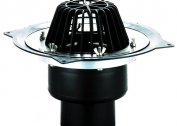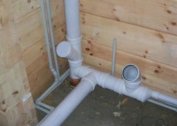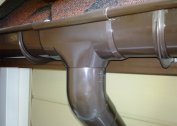The red sewer pipe with a diameter of 250 mm is the most frequently used product when installing external sewage systems. Since the street highway is subjected to static and dynamic loads, special requirements are imposed on the selection and installation of its components. Product specifications are dependent on length and operating requirements.
Scope of plastic sewer pipes with a diameter of 250 mm
The outer dimension is indicated in the pipe marking, so you have to calculate the inner diameter yourself, subtracting the wall thickness from the existing indicator. For external drainage networks, the diameter is not regulated, however, there are recommendations on which the size of the pipe at the outlet should not be less than the external line.
For suburban areas choose pipes from 110 to 250 mm. In systems with more significant load, the diameter can be increased up to 400 mm. The wall thickness varies depending on the length of the produced segments.
Scope of products with a diameter of 250 mm:
- Sewer pipes and fittings are often used for internal wiring in drainage systems.
- Drain of melt water and household waste from residential and industrial facilities.
When choosing pipes for production facilities, it is worth paying attention to the level of acidity in the system - the pH should be from 2 to 12.
Specifications
Sewer pipes made of polyvinyl chloride are made from high quality raw materials. They are designed to transport wastewater in an external sewage system with temperatures up to 60 degrees. For a short time (up to 2 minutes), water supply up to 100 degrees is allowed.
Technical characteristics of PVC pipes of 250 mm in size have the following characteristics:
- The density of the material is 1410 kg / m3.
- Heat capacity - 1.0 J / g.
- The modulus of elasticity during deformation of 1 mm / min is 3000 MPa.
- Thermal conductivity at a temperature of 23 degrees - 0.15 W / m.
- The maximum bending radius of the pipe is 300 mm at a temperature of 20 degrees.
- Installation in temperature conditions from -5 to +90 degrees.
The advantages of PVC pipes for external sewage include high strength, low weight, resistance to internal wear and tearing of walls, corrosion resistance. Since plastic products are more durable when used in a humid environment, their installation in the sewage system is more profitable than the installation of metal elements.
The service life of plastic pipes with a diameter of 250 mm is 30-40 years, although manufacturers give a guarantee for 10 years of service. A long period of operation is observed subject to standards that do not allow unnaturally intense loads.
When calculating systems based on fluid circulation, it becomes necessary to determine the throughput of pipes. This value characterizes the volume of fluid that is transported through pipes over a certain period of time. This indicator is directly related to the material from which the sewage system is made. Plastic products have the same throughput throughout the entire period of operation. Plastic is not subject to corrosion, so the inner surface remains smooth until the damaged parts are removed.
When calculating the pipeline capacity, the length of the section from the internal sewage to the point of insertion into the central highway or septic tank is important.The greater the distance the fluid travels, the less pressure is created in the pipes, which means that the flow rate decreases. For pipes with a diameter of 250 mm laid with a slope of 0.008 and a sink speed of 1.09 m / s, the water flow rate is 33.6 l / s.
Mounting Features
Pipes with a diameter of 250 mm are often used for external sewage, therefore, when installing them, it is necessary to take into account the features of the external network device. Stages of work:
- Creating a network diagram. In the compiled documentation indicate the features of a particular site. The plan marks the location of the pipes. The circuit should be preserved even 10 years after operation.
- Pit marking. It is performed using twine and pegs. It is better to use this method, since the marks on the ground are easily erased. If marking errors are made, system malfunctions may occur during operation.
- After marking the ground, digging a pit begins.
- The bottom layer of the pit is covered with pebbles, which helps to prevent the soil from being pressed through to protect the pipes from groundwater. In addition, such a measure improves the thermal insulation of sewers.
Since plastic pipes are easily frozen, they are wrapped with metallized material on a polyethylene basis. They also cover the entire bottom of the pit for the septic tank. The metal surface should face up.
Assembling an external sewage system using pipes with a diameter of 250 mm consists in immersing all elements of the system in a pit and trenches suitable for it. Subsequently, individual sections of the network are connected to each other, and the joints are sealed with tape or special liquid.
To insulate the pipe, it is wrapped with glass wool or polyester. This measure prevents the freezing of runoff in the winter. Bury the trunk after testing the system. It is possible to check the system for performance only after the sealant has completely dried, which can take from several hours to several days.
 PVC sewer pipes can be connected in two ways:
PVC sewer pipes can be connected in two ways:
- Glue (cold welding). A composition capable of connecting the elements at the molecular level is applied to the fittings.
- Bell-shaped. Docking of sections is carried out by deepening direct products into sockets pre-treated with sealant.
The key to the wireless functioning of the external sewage system is strict compliance with the installation technology. When constructing a highway, certain rules must be observed. At the bottom of the trenches, a gravel-sand pillow is covered. It protects the pipeline from damage during seasonal soil movements. The trunk must be laid at a slope of 2-15%. If you need to change direction, use bends by 15-30 degrees. Every 15 m of sewage it is worth installing revisions. When backfilling the ditch, the soil is tamped only laterally. The soil under the highway does not require tamping.
The cost of plastic pipes with a diameter of 250 mm
All pipes with a large diameter are sold in segments of several meters. Prices for plastic sewer pipes with a diameter of 250 mm depend on the meter, wall thickness, density and processing characteristics of the material.
Non-pressure plastic pipes with a diameter of 250 mm cost 550 p. per linear meter, pressure head - 650 r. Their main difference is the wall thickness. This indicator greatly increases the cost of production. Corrugated pipe, due to its greater strength, costs from 700 to 750 p. for 1 m
Subject to the rules for laying the sewer line and the conditions for its operation, the service life of the system will be comparable with the lifetime of the house itself. Regular work includes inspection of inspection hatches and periodic pipe cleaning.





